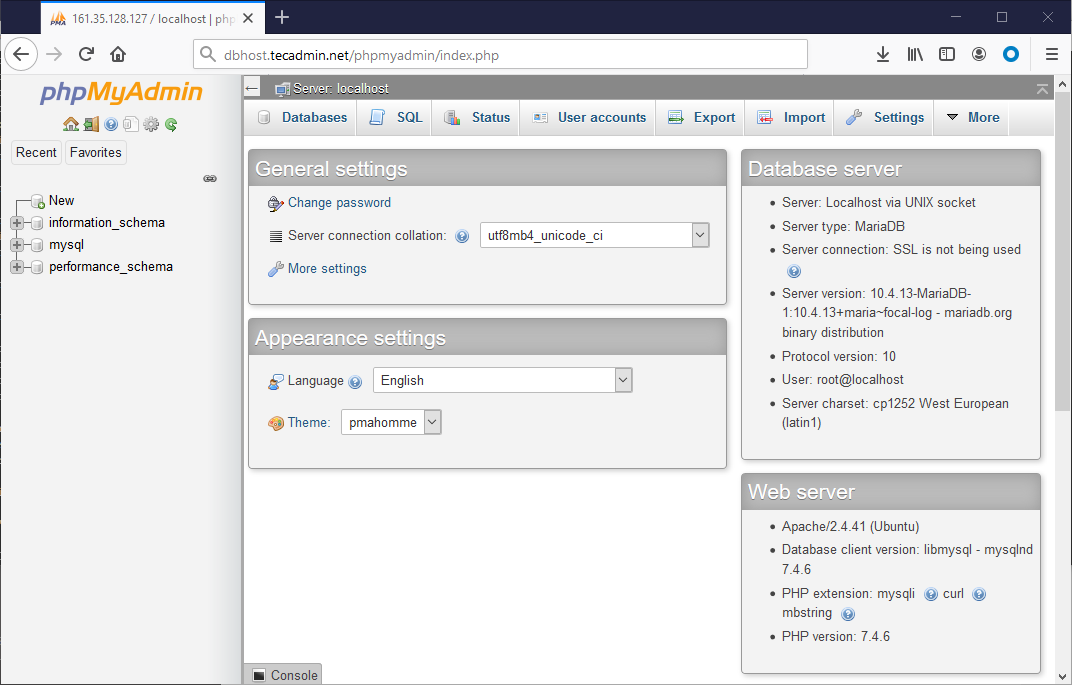

- #Ubuntu install phpmyadmin 16.04 how to#
- #Ubuntu install phpmyadmin 16.04 update#
- #Ubuntu install phpmyadmin 16.04 password#
Now press Ctrl+X and type Y and press Enter button to save & exit… To test the PHP installation PHP version, we need to first create the info.php file in the document root folder under /var/Use the following commands:įirst, we create an info.php file for that run the commands in the terminal given below: sudo nano /var/www/html/info.phpĪfter executing the above command, a nano editor will open, now copy paste the below parameters… Open a web browser and navigate to You will find a default page of Apache2 as showm in the screenshot… apt-get -y install php7.0-opcache php-apcuĪfter the installation of MySQL and PHP, its time to restart the Apache web server by running the following command in your Ubuntu terminal. First check, is phpMyAdmin already installed by using localhost/phpmyadmin on the browser. You can enable Apache & PHP modules as per your wish, and also use many useful Linux utilities in your PHP code. We also install the php-apcu, to provide the cache function of the APC cache to Opcache which is another caching system to provide compatibility to different CMS systems. Installing latest versions of Apache, MySql, PHP & phpMyAdmin on Ubuntu 16.04 (over an AWS EC2 Instance) Having your own VPS or a Dedicated Server offers a lot of freedom as compared to a Shared Hosting plan. If you want to speed up the PHP 7 you can also install the opcode cacher to speed and optimize the PHP page. Php7.0-xmlrpc php7.0-xsl php7.0-mbstring php-gettext Php-imagick php7.0-imap php7.0-mcrypt php-memcache php7.0-pspell Now we need to add MYSQL support to PHP and for that, we need to install a couple of packages here is the command apt-get -y install php7.0-mysql php7.0-curl php7.0-gd php7.0-intl php-pear sudo apt-get -y install php7.0 libapacher-mod-php7.0 Run the following to setup PHP on your Ubuntu server. To install PHP 7.0 on Ubuntu 16.04, open the terminal to install meta packs php7.0 and libapache2-mod-php7.0. To access the MySQL database from the browser interface we need to install the phpMyAdmin apt-get -y install phpmyadmin Step 4: Install PHP on Ubuntu Enter your password…Īnd the MySQL database will successfully installed on your Ubuntu system. Something, like shown in the below screenshot, will appear.
#Ubuntu install phpmyadmin 16.04 password#
sudo apt-get install mysql-serverīetween the installation of MySQL, the system will ask to set the root password for MySQL database. Again on the terminal run the below command and then press “Y” to install it. To install the MySQL database on Ubuntu you need to run a command given in this step to install the mysql-server package. It will confirm before installation of apache2, just type ‘ Y‘ and press Enter Key. Install PHP Modules To enhance the functionality of PHP, we can optionally install some additional modules.
#Ubuntu install phpmyadmin 16.04 update#
You can install it directly from the Ubuntu Software Center by searching for it or just open the Ubuntu terminal and run the following command: sudo apt-get updateįirst, update your Ubuntu system by running the update command and after that use the second to install the Apache. Set the 'ServerNam Apr 13 14:28:43 ubuntu-16-lamp apache213605: Apr 13 14:28:43 ubuntu-16-lamp systemd1: Started LSB: Apache2 web server. To enable the Apache web server on Ubuntu 16.04, we just need to install one Metapackage that contains all libraries and dependencies for Apache web server i.e apache2.
#Ubuntu install phpmyadmin 16.04 how to#
How to Install Memcached on Ubuntu 18.04/16.Step 7: Check PHP Install Linux, Apache, MySQL, PHP (LAMP) stack on Ubuntu 16.04

Additionally, I will install PHPMyAdmin to make MySQL administration easier. Related Articles: How to Install MariaDB on Ubuntu 18.04/16.04 LTS This tutorial shows how you can install an Apache web server on an Ubuntu 16.04 LTS (Xenial Xerus) server with PHP 7 (modphp) and MySQL / MariaDB support and how to setup an SSL certificate with Let's encrypt.

In this article, We have performed ,How to Install phpMyAdmin on Ubuntu 18.04/16.04 LTS System. Open browser on your system and Type ServerName or IP, Conclusion: To take effect restart apache2 $ sudo systemctl restart apache2 Step 4: Access phpMyAdmin $ sudo phpenmod mbstringĮnable phpMyAdmin in /etc/apache2/nf $ sudo nano /etc/apache2/nfĪdd below line at end of file. Type the password, Select “OK” and Enter.Įnter below command to enable mbstring. Next it will asks for Database administrator password. Select “ Yes” and EnterĮnter the password for phpmyadmin application. It will ask to configure database for phpmyadmin which you have already installed. While installing it will asks to select web server which you have installed on your system.


 0 kommentar(er)
0 kommentar(er)
